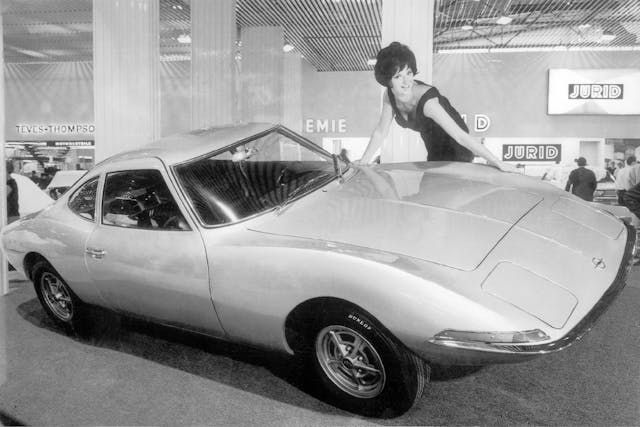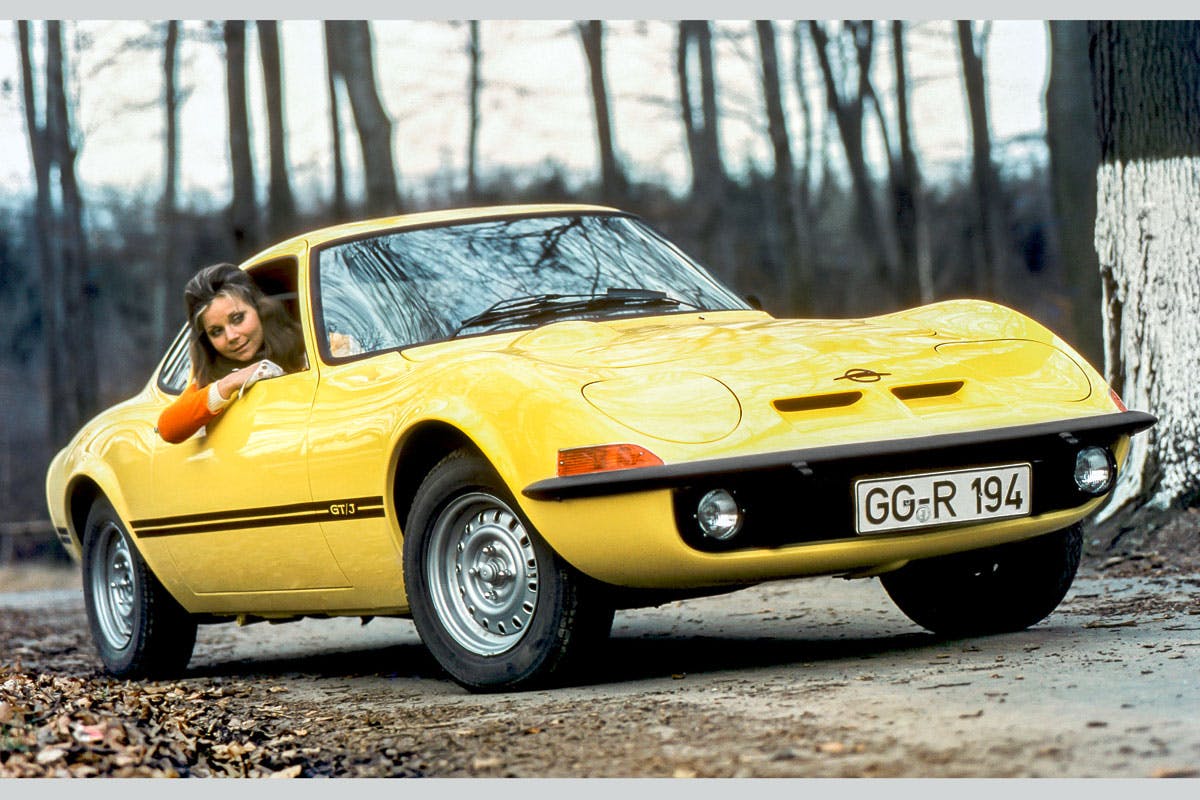Cars That Time Forgot: Opel GT
Opel had a problem in the mid-1960: Its cars were terminally dull. Sure, the German company was far from unique in this respect, but unlike many of its rivals, Opel decided to do something about it, and that was to inject some sex appeal into the range.
The first signs of Opel’s ambitions were seen at the 1965 Frankfurt motor show, when the company unveiled an experimental coupe. Called simply ‘GT’, this rakish sportster was nothing more than a humdrum Kadett underneath (albeit with a Rekord engine), but ex-Corvette designer Clare MacKichan did a great job of coming up with the lines for Opel’s first two-seater sports car since 1924.

Despite constant denials, Opel planned all along to create a production version of the GT, but it kept its powder dry for several years, claiming that the GT was nothing more than a show car. However, everyone assumed that the concept would reach production in some form, probably with a fiberglass body shell, so it was no surprise when in 1968 the GT burst onto the scene in steel-bodied form, a year before Ford’s Capri did the same. While the Capri became an instant classic and lasted for three generations over a 17-year production run, the GT was killed off after just five years, and it is now largely forgotten.
Intended to be a sports car for the younger driver, and marketed with the slogan “The first common market sports car,” the Opel GT could be ordered with a 1078-cc engine that pushed out just 67 hp. But few chose this route. Instead, most went for the 1897-cc alternative that provided a marginally more enticing 89 hp. Even with this engine the GT was no ball of fire; it got to 60mph from stationary in a shade under 10 seconds and topped out at 112mph.
Up front there was independent suspension, while retractable lights (which swiveled into position) boosted the car’s sporting credentials. The floorpan, engine, gearbox, brakes, and suspension were all taken from the Kadett or Rekord, and while 1.1-liter editions had smaller brake drums at the back and a lower final-drive ratio, both models had identical bodywork and trim. Standard fare was a four-speed manual transmission, but 1.9-liter GTs could be ordered with a three-speed automatic instead.
As soon as the GT went on sale, it was a hit. Opel had planned to build 60 cars per day, but production quickly doubled, which was easier said than done. Parisian company Chausson produced the body shells, while Brissonneau & Lotz, also based in Paris, was commissioned to take care of body trimming and painting. When the GT proved to be such a hit, Opel had to lend a hand by also finishing cars in its factory in Bochum, Germany.


Part of the reason for the GT’s early success was its availability in the U.S., where it was sold through Buick dealers. Differences on the theme were minor between Federal and European variations; U.S.-spec cars usually lacked anti-roll bars and a heated rear window, for instance. European cars could be specified with a radio, three-speed automatic gearbox, fog lights, and a passenger-side door mirror, but available on both sides of the Atlantic was a ZF limited-slip differential, although not that many buyers paid the extra for one.
Although the GT was billed as a 2+2, the back seat wasn’t a place in which anyone would want to spend a significant amount of time. At a push you could just about squeeze one passenger in sideways, behind the high-backed front seats, and as if that wasn’t enough, there was no trunk lid or tailgate. Instead, any luggage had to be fed into the cargo area via the back seat. It wasn’t as though there was much carrying capacity anyway; the spare wheel took up most of the available space.

When Motor tested the GT in March 1969, writer Paul Frére noted: “The GT is extremely well behaved and should go a long way to change public opinion about the roadworthiness of Opels. With radial tyres, good weight distribution and rather stiff springs, both handling and roadholding are excellent. On faster bends the car is almost completely neutral and cornering speeds quite high. The light and very positive rack-and-pinion steering combine to make up a car which is extremely pleasant and enjoyable to drive.”
Sales ticked over quite nicely at first, but by 1971 demand had started to wane. In an attempt to boost interest, Opel introduced the cheaper GT/J, with simplified instrumentation, trim, and exterior brightwork. It came only in 1.9-liter form, the 1.1-liter engine having been canned by this point, due to a lack of demand. The GT/J helped to boost sales a little, but the days of Opel’s affordable sports car were numbered.
Tougher U.S. impact rules led to the GT’s demise in 1973; it wasn’t worth it for GM to engineer the car to pass, as sales had slowed to a trickle. Of the 103,463 GTs built, by far the rarest was the 1100, with just 3573 examples made. The GT/J was the next rarest, with 10,760 built, while the 1900 GT accounted for the bulk of production, with 89,130 rolling off the production lines.
That wasn’t the end of the GT brand, though, because it was revived in 2007, for an all-new model that would be sold in the U.S. as the Pontiac Solstice and Saturn Sky. GM would revive the GT name once again on a 2016 concept, but now that Opel is part of Stellantis, the arrival of yet another GT seems highly unlikely.
***
Check out the Hagerty Media homepage so you don’t miss a single story, or better yet, bookmark it. To get our best stories delivered right to your inbox, subscribe to our newsletters.









I had two friends at different times that had nice versions. One car I drove pretty regularly, the other I did a bit of deferred tune-up work on. I loved the build quality, great looks, and driving experience. I’d welcome the chance to drive a well-kept example!
Georgen Where do you live? I need a tune up in Ohio on a 73 GT!
I always liked the looks of them.
My mother helped my younger sister get one. As I remember it, shortly thereafter, Opel announced it was discontinued. Quite angry, expecting the worst, Mom gave the local Buick dealer who sold it to them, a “piece of her mind”. My mother seldom got really angry, but when she did… I wish I’d been there.
A friend of mine wanted to buy one, but the Buick dealer was selling them for more than sticker price in Los Angeles. I asked if we both bought one would he give us a deal and he said he would knock off $50. That is when we walked out.
I was a mechanic in the70’s and worked on and drove several of the Opel GTs. Nice little cars, reasonably peppy for the day, decent transmission, cool roll over headlights, nice styling, commonly called a Baby Vette. I remember them fondly. The 1100 model? I’ll forget that one. Disappointingly slow.
It’s worth noting the unusual Cam in Head engine design of the 1900. The camshaft was located in the head but below the valve stems, operating the valves through rocker arms, sort of like a pushrod engine but without the pushrods. I have not seen this design used elsewhere, although I’m sure somebody used it.
Yes a similar cam on rocker design was used in the Pontiac OHC six cylinder engine and worked well. It is worth noting Chevy passed on this proven reliable design to go with a version of the cheaper English Vauxhall cam on tappet buckets on top of the valve stems for the Vega that resulted in oil loss via the valve stems. The tappet buckets forced oil past the valve seals after awhile resulting a lot of oil consumption!! If cheap GM had just used the German Opel engine (Pinto used the German Ford OHC engine) the Vega would have been so much better.
I remember mine, could never get those headlights to deploy properly – either open or closed! And the charging system was atrocious. It handled great. Had to always keep the windows down to keep the exhaust fumes from poisoning me! What a great time, back in 1978.
I had a yellow ‘71 Opel GT in HS. I put Crager S/S mags and a plastic wind up toy key suctioned on the back lid. Lol Bought it off my dad after he abandoned it in the side of the road as he couldn’t drive that p-o-s anymore. Personally, I loved it. Unfortunately, someone stole it and it went under a cement truck. I get to relive the days, as there is the same car at the physics lab near my house.
In the U.S.A. the GT was sometimes mocked as a “mini-vette”, but those that bought them enjoyed the car. In spite of the reference to the “antiquated” Kadette underpinnings the cars handled well (as many magazines stated). While it was not a fireball by today’s standards, 0-60 in ten seconds was quite respectable for the time and better than many other small “sports cars” of the era. By the early 70’s even some big engine cars had difficulty manages 60 in 10 seconds! I was lucky enough to work at a company that bought Opel Kadett wagons for field service vehicles when the U.S.A Opels ALL came with the 1900cc engine (no doubt to simplify emissions qualifications). That 1900cc Kadett wagon was fun to drive. I recall I outran somebody in a new 1973 Chevrolet Impala!! Granted a 73 emission equipped Impala wasn’t that fast, but the point is the Kadett’s acceleration was acceptable and it was a fun car to drive. I regret never having the chance to drive a GT.
It came back as the European version of the Saturn Sky/Pontiac Solstice…
Not forgotten by old sports car enthusiasts. I thought they were very cool back in the day. Great article, didn’t know they were available with a limited slip, or production numbers, or that there was an economy model.
Would like to see a head to head comparison test of an Opel GT and a Saab Sonett
I desperately wanted one in 1969. A family “friend” who sold used Chevys told me they were a “bucket of bolts”. Crushed my ambitions on the spot. In college there was a coed we referred to as the “mini-brute”. Ah, college days.
The OPEL GT… The cutest, most lovely coupe standing still! The OPEL GT died during my senior year in High School… I followed it from its debut. And I said I’d own one someday.
50 years later, I STILL want this BEAUTY. The GT was slow and underpowered. But the LINES! Hotter than Raquel Welch! And, no trunk at all. Whatever you could stow behind the seats. That little SPINNER gas cap! So CUTE! I’ll get one someday. Hopefully on a decent condition.
I had two of them in the Mid 70’s when I was in my early twenties and my husband sold Buicks. One gray, the later one blue. I spotted the first one on the used lot and said “I want it”. Just the right size for me and so much fun to drive, especially on curvy roads. My husband and I did a trip to New Orleans with one small suitcase and the baby in his carseat crammed into the package shelf. 1000 (fast) miles each way. FUN (really!). Son number two ended the GT fun although the pristine “little old lady’s” Rambler Ambassador trade-in with its brocade seats and capacious trunk did have it’s charms.
I always wanted another Opel GT but guess I’ll have to settle for a Miata if I want another fun small car.